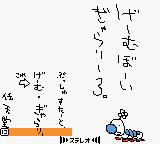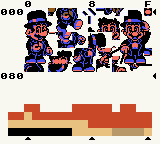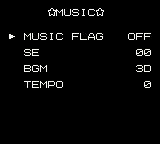Game & Watch Gallery 3
| Game & Watch Gallery 3 |
|---|
|
Also known as: Game Boy Gallery 3 (JP), Game Boy Gallery 4 (AU)
|
| To do: More regional differences. |
The third / fourth game in the Game & Watch / Game Boy Gallery series.
Contents
Classic Mode: Very Hard
This graphic is found with the rest of the Interrupt Save graphics, as it was in Game & Watch Gallery. They still wanted to do a Very Hard difficulty for the Classic Mode, but alas, it was never finished.
Each of the five starting games will load a partially programmed Classic Very Hard mode. Only the save interrupt was implemented. It is still possible to display the graphic for each game by using the below GameShark codes, though all games will behave exactly like Game B.
| Game | Code |
|---|---|
| 010213C7 | |
| 010219C7 | |
| 010215C7 | |
| 01021BC7 | |
| 010217C7 |
Early Title Screen
An early title screen (likely a placeholder) is still in the game in all Game Boy forms, and can be accessed with Game Genie code 0C1-F7F-916 or the debug menu (see below). Pressing Start takes you to the normal title screen.
Game Boy Color
Super Game Boy
Game Boy Gallery 3. Push Start. Game Gallery This -> Nintendo (Ni) Stereo
DEBUG MODE
An extensive debug menu remains in the game, almost completely intact! Use GameShark codes 0101A6C0 0101A7C0 or Game Genie code 011-F7F-916 to access the debug menu. Be sure to turn the GameShark code off when you enter the debug menu.
DATE is the game's build date in YYMMDD format.
| Version | String | Date |
|---|---|---|
| Japan | 990312 | March 12, 1999 |
| International | 990721 | July 21, 1999 |
Game, Demo, and Music have their own menus.
GAME
GAME
Select what game to play. That's already apparent. Press A to play that game.
MODE
What difficulty you want. Classic modes have Game A and Game B, while Modern modes have Kinoko (Mushroom), Flower (Hard), and Star (Very Hard).
SCORE
This should set your score, but this doesn't seem to work.
MISS
Should set your miss count, but this doesn't seem to work either.
DEMO
DEMO
Select which Demo you want to see.
- Title: Placeholder title screen.
- Game Select 1: Main game selection menu.
- Game Select 2: Unlocked game selection menu.
- Mode Select: Difficulty / Modern / Classic game menu.
- Staff Roll: Credits.
- G Comer: Gallery Corner.
- G Museum: Museum.
- G Present: Gift screen.
- G Message: Note Board.
- G Message 2: Message screen.
- G Room 1~0: Fire museum demo (crashes game).
- G Room 1~1: Mario Bros. museum demo (crashes game).
- G Room 1~2: Boxing museum demo (crashes game).
- G Room 1~3: Greenhouse museum demo (crashes game).
- G Room 1~4: Donkey Kong museum demo (crashes game).
- G Room 1~5: Life Boat museum demo (crashes game).
- G Room 1~6: Spitball Sparky museum demo (crashes game).
- G Room 2~0: Egg museum demo.
- G Room 2~1: Donkey Kong Hockey museum demo.
- G Room 2~2: Pinball museum demo.
- G Room 2~3: Balloon Fight museum demo.
- G Room 2~4: Donkey Kong Circus museum demo.
- G Room 2~5: Super Mario Bros. museum demo.
- G Room 2~6: Climber museum demo.
- G Room 2~7: Donkey Kong II museum demo.
- G Music: Music Room.
- Real Title: Final title screen.
- Fire 1: Reversed layout Fire.
- Fire 2: Reversed layout Fire explanation.
- Fire 3: Reversed layout Fire menu.
- 150: 150 Stars cutscene.
SCREEN
Select what screen you want to play.
- 00: Placeholder title screen.
- 01: Main game selection menu.
- 02: Unlocked game selection menu.
- 03: Difficulty / Modern / Classic game menu.
- 10: Classic Egg.
- 11: Modern Egg.
- 12: Classic Turtle Bridge.
- 13: Modern Turtle Bridge.
- 14: Classic Donkey Kong Jr.
- 15: Lion.
- 16: Classic Greenhouse, Top Screen.
- 17: Classic Greenhouse, Bottom Screen.
- 18: Modern Greenhouse.
- 1A: Classic Mario Bros.
- 1B: Modern Mario Bros.
- 1C: Modern Donkey Kong Jr., Screen #1.
- 1D: Modern Donkey Kong Jr., Screen #2.
- 1E: Modern Donkey Kong Jr., Screen #3.
- 1F: Final title screen.
- 20: Judge.
- 21: Spitball Sparky.
- 22: Flagman.
- 23: Donkey Kong II, Top Screen.
- 24: Donkey Kong II, Bottom Screen.
- 25: Credits.
- 26: Gallery Corner.
- 27: Museum.
- 28: Gift screen.
- 29: Note Board.
- 2A: Message screen.
- 2B: Egg museum demo.
- 2C: Donkey Kong Hockey museum demo.
- 2D: Pinball museum demo.
- 2E: Balloon Fight museum demo.
- 2F: Donkey Kong Circus museum demo.
- 30: Super Mario Bros. museum demo.
- 31: Climber museum demo.
- 32: Donkey Kong II museum demo.
- 33: Fire museum demo (crashes game).
- 34: Mario Bros. museum demo (crashes game).
- 35: Boxing museum demo (crashes game).
- 36: Greenhouse museum demo (crashes game).
- 37: Donkey Kong museum demo (crashes game).
- 38: Life Boat museum demo (crashes game).
- 39: Spitball Sparky museum demo (crashes game).
- 3A: Music Room.
OBJ
Displays object graphics. Press Left and Right to cycle through object frames.
V~RAM
Displays contents of the appropriate VRAM bank. No controls here, other than pressing B to exit.
MUSIC
MUSIC FLAG
This should probably set the Music variable on/off, but it never seems to save a value either way.
SE
Play sound effects.
BGM
Play music tracks. Hitting Left / Right will automatically play the track you select.
TEMPO
Changes the tempo of the current track. Ranges from 0-F, with 0 being the fastest and F being the slowest.
DATA
Normally inaccessible from the main debug menu, due to a bad pointer. However, by using Game Genie code 051-F7F-916, you can start at the Save Interrupt screen. Your current game and information is shown. You can erase the save interrupt by setting DATA CLEAR in the Save menu.
RESUME GAME
Starts your currently saved game.
TO THE MENU
Returns to the main debug menu screen.
SAVE
Game Data management has two options, DATA CLEAR and ALL CLEAR. The former will erase your save interrupt status, while the latter will clear your game records, remove all of your unlocked games, and delete your save interrupt session.
DATA
ID 06.
A slightly corrupted screen showing statistic and information about the ROM. The palette was never programmed for the GBC mode; only SGB mode has a proper palette.
Super Game Boy Palette Masking
When Game & Watch Gallery 3 was localized to the US, the SNES controller's A/B-button palettes were not changed to reflect the US blue and purple buttons. Rather than update the palette completely, they forgot to update the attraction attributes, leaving the original code assigned to the palettes visible.
This can be seen by exploiting a palette glitch which involves clicking on the camera icon then waiting for the palettes to change. The easiest way to do this is to pause and exit Classic Flag Man, although it can be done using any game's Classic mode.
Unused Graphics
Tons!
Modern Egg
Gallery Corner
There are two unused Star icons and unfinished path.
There is an unfinished path that shows two inaccessible buildings and a few unused graphics. It is unknown what buildings or features may have been planned.
GameShark code 01??72C0 will display either unused star icon.
Gift
Early Title Screen
The early title screen has several unused graphics, and some very strange ones at that.
Regional Differences
Title Screen
| Japan | US/Europe | Australia |
|---|---|---|

|

|
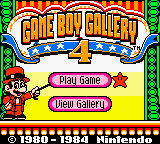
|
Much like Game & Watch Gallery 2, the copyright years for the international versions are that of the original Game & Watch games, rather than the actual release years for the compilation in the Japanese version.
Museum
| Japan | International |
|---|---|

|
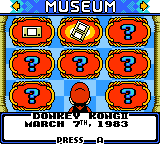
|
Much like in the previous two games in the series, some museum panels in the Japanese version display the initial retail price information of the games that were released there. The international versions, meanwhile, once again exclude this information.
| Japan | International |
|---|---|

|
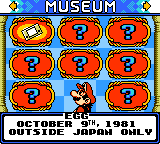
|
For the games that were not released in Japan, the Japanese version displays かいがいのみ ("overseas only") in place of the initial retail price information, while the international versions (obviously) display the Outside Japan only text.
Staff Credits
In the Japanese version, Yasuo Inoue and Sachiko Nakamichi are credited as artwork designers while programmer Toru Fushimi's surname is spelt Fusimi. The international versions, meanwhile, replace the first two with translators Paul Rush and Bill Trinen.
Cast Credits
Oddly enough, the only change that the international versions made was correcting the spelling of Luigi's name, as it was originally spelt "Luige" in the Japanese version. The other characters, meanwhile, retained their romanized Japanese names.
Miscellaneous
The 150 congratulations screen does not exist in the original Japanese version.
The Game & Watch series
| |
|---|---|
| Game Boy (Color) | Game Boy Gallery • Game & Watch Gallery • Game & Watch Gallery 2 • Game & Watch Gallery 3 |
| Game Boy Advance | Game & Watch Gallery 4 |
| Nintendo DS | Game & Watch Collection • Game & Watch Collection 2 |
| Handheld Units (modern) | Game & Watch: Super Mario Bros. |
- Pages missing developer references
- Games developed by TOSE
- Pages missing publisher references
- Games published by Nintendo
- Game Boy games
- Super Game Boy games
- Game Boy Color games
- Pages missing date references
- Games released in 1999
- Games released in April
- Games released on April 8
- Games released in December
- Games released on December 6
- Games with unused game types
- Games with unused graphics
- Games with debugging functions
- Games with hidden sound tests
- Games with hidden level selects
- Games with regional differences
- Games with revisional differences
- To do
- Game & Watch series
Cleanup > Pages missing date references
Cleanup > Pages missing developer references
Cleanup > Pages missing publisher references
Cleanup > To do
Games > Games by content > Games with debugging functions
Games > Games by content > Games with hidden level selects
Games > Games by content > Games with hidden sound tests
Games > Games by content > Games with regional differences
Games > Games by content > Games with revisional differences
Games > Games by content > Games with unused game types
Games > Games by content > Games with unused graphics
Games > Games by developer > Games developed by TOSE
Games > Games by platform
Games > Games by platform
Games > Games by platform
Games > Games by publisher > Games published by Nintendo
Games > Games by release date > Games released in 1999
Games > Games by release date > Games released in April
Games > Games by release date > Games released in April > Games released on April 8
Games > Games by release date > Games released in December
Games > Games by release date > Games released in December > Games released on December 6
Games > Games by series > Game & Watch series
The Cutting Room Floor > Unimportant Awards > Game Boy games
The Cutting Room Floor > Unimportant Awards > Game Boy games > Game Boy Color games
The Cutting Room Floor > Unimportant Awards > Game Boy games > Super Game Boy games

